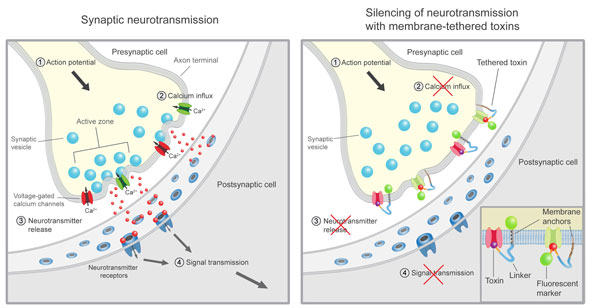| Posted: March 8, 2010 |
New tool to investigate the function of ion channels in neurons |
|
(Nanowerk News) Neurotoxins from cone snails and spiders help neurobiologists Sebastian Auer, Annika S. Stürzebecher and Dr. Ines Ibañez-Tallon of the Max Delbrück Center for Molecular Medicine (MDC) Berlin-Buch, Germany, to investigate the function of ion channels in neurons. Ion channels in the cell membrane enable cells to communicate with their environment and are therefore of vital importance. The MDC researchers have developed a system which for the first time allows the targeted, long-lasting investigation of ion channel function in mammals and also the blockade of the ion channels with neurotoxins. In transgenic mice they succeeded in blocking chronic pain by introducing a toxin gene into the organism ("Silencing neurotransmission with membrane-tethered toxins").
|
|
There are approximately 500 species of cone snails, each producing 50 – 200 different conotoxins. A similar number of peptide toxins are produced by snakes, spiders, sea anemones, scorpions and other venomous animals. The animals use the neurotoxins to paralyze their prey. Scientists estimate that more than 100,000 neurotoxins exist. They have become a topic of enormous research interest: Using neurotoxins researchers can target different ion channels, receptors and other signaling molecules and characterize their physiological function.
|
 |
| Neurotoxins of cone snails and spiders block neurotransmission and chronic pain (Graphics: Sebastian Auer, MDC)
|
|
This kind of research can also give them insight into disease processes and eventually help them to find new therapies to eventually block hyperactive ion channels. For instance, a compound (Ziconotide) based on the toxin of a cone snail is already used to treat severe chronic pain in patients. Dr. Ibañez-Tallon’s research group is concentrating on two ion channels in the membrane of neurons which are activated by electric stimulation (action potential). Once activated, they allow the influx of calcium ions into the neuron, and the cell then releases chemicals (neurotransmitters), which send the signal to the next neuron.
|
|
During the last decades soluble neurotoxins have greatly helped in the characterization of ion channels and receptors because of their ability to specifically bind and inhibit these channels. However, soluble neurotoxins can only be applied for limited time, and their activity cannot be directed to specific cells. Sebastian Auer, Annika S. Stürzebecher and Dr. Ibañez-Tallon managed to circumvent this problem with genetic engineering. Using lentiviruses they developed a shuttle to deliver the genes of cone snail and spider toxins into the neurons. The result: The neurons now long-lastingly produce toxins which directly bind to the calcium ion channels the researchers want to investigate.
|
|
This was the first step – the targeted and long-lasting binding of the toxins to a specific ion channel in the cell culture. Secondly, the researchers were able to demonstrate that with their tool they can also express toxin genes in animals in a targeted way and also lastingly characterize ion channels. In transgenic mice they were able to block certain calcium ion channels with their toxins and thus block chronic pain.
|

